Libertad o Muerte! (Liberty or Death, or LoD) covers the Spanish Colonies’ wars of independence from Spain from 1810-1825. Players control the Patriots or the Royalists in turn-based fashion through four introductory scenarios and the 30-turn “Great Campaign.”
In the latter, the map stretches region-by-region from Santa Fe (Mexico) in the north to Cape Horn at the tip of South America. Even without Brazil in play, that’s a large chunk of real estate, but the nature of the gameplay makes handling such a sizable map quite easy.
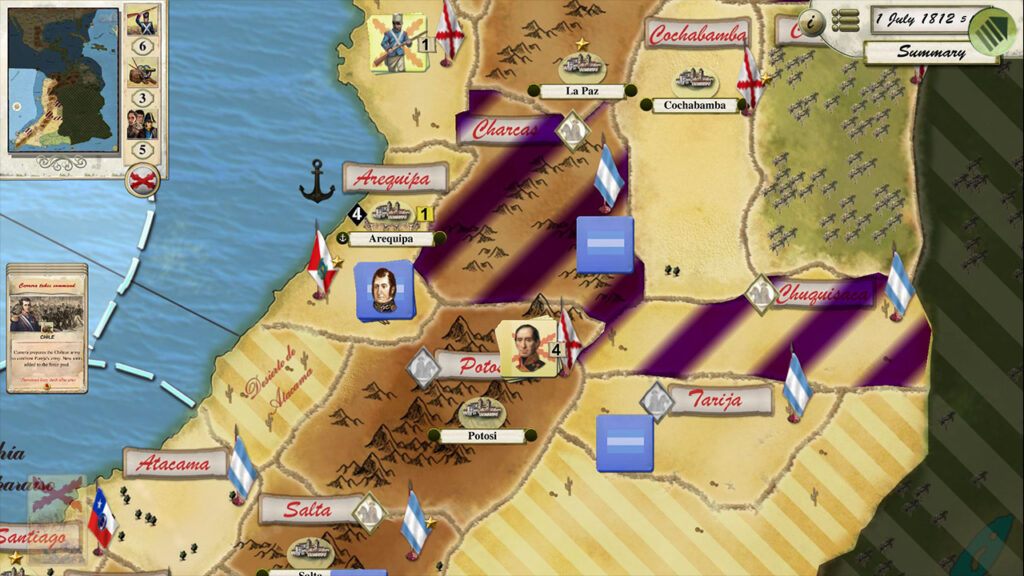
This latest title follows a string of wargame releases by publisher Avalon Digital, including the superlative Carrier Battles 4 Guadalcanal, Battles for Spain (based on the excellent Wars Across the World (WaW) series module), and Winter War (WW).
To this writer’s knowledge, amidst the thousands of digital wargames published since the early 1980s, none have been released depicting the Americas’ 19th-century struggle for freedom against Spain. For wargamers interested in the period, this game would appear to be a must-buy; for the rest of us, well, read on.
We suspect that owners of War Across the World and Winter War might naturally gravitate toward this game, as it holds a few things in common, in addition to it coming from the same publisher. Libertad o Muerte!’s graphics feature a period-feel of sorts, which results in a rather low-res look for the map, cutscenes, cards and unit counters compared with Avalon’s previous releases.
This is doubly so in comparison with War Across the World. In that game, the struggle between Finland and the USSR in 1940 is played out with the most wonderful-looking and detailed unit counters around. Hover the mouse over one, and up pops a zoomed-in counter with highly detailed unit data and tooltips everywhere.

The card system is pretty much a big part of the historical immersion. One will learn quite a bit about a rather esoteric group of commanders and events that occurred during the time period covered from the card system.
On one hand, allowing the program to choose the appropriate cards for use at the proper time moves the game forward without a lot of fuss. But some may miss a card design that allows players to make difficult choices in terms of what card to play, which would add another strategic layer to the game. However, adding this feature would require a complete redesign, as the events and bonuses would need to made optional in order to give players a choice on when to play their cards.
Overall, the implementation of the event and combat cards may be seen as a mixed bag. The historical flavour provided by designer Miquel Santacruz on each of the cards is brief but generally good, and the game speeds along on rails partly for this reason. But the whole process may be a bit too automated for those looking to both study opponent’s cards and use their own to the greatest effect.
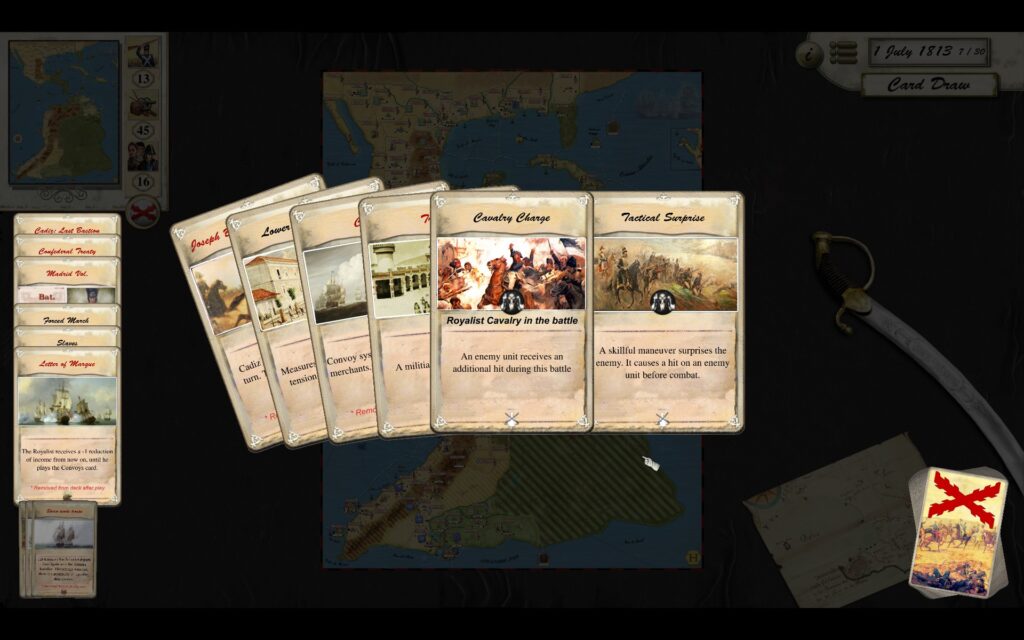
Beginning with the movement of units on the strategic map, the entire combat system is quite streamlined. But there’s one thing almost everyone can appreciate. And that’s the game’s ability to avoid the horrendous “wack a mole” routine, whereby a player or the AI uses a “doom stack” to clear enemy units from the board. With approximately 80 regions on the campaign map and reinforcements popping in on a regular basis, there was a real risk of gameplay devolving into such a senseless struggle.
In addition, land units are realistically limited to one region per move based on the actual time being simulated. (Naval units can typically move two to three sea regions per turn.) This also encourages players to choose their moves carefully, as the game map remains open to a variety of strategies.
One missing feature that hopefully will be addressed in a patch is the ability to show detailed counter information in every phase of the game. However, in the combat resolution phase, this feature is missing. On the battle summary screen, it works, but the pop-up box is mostly blocked from view.
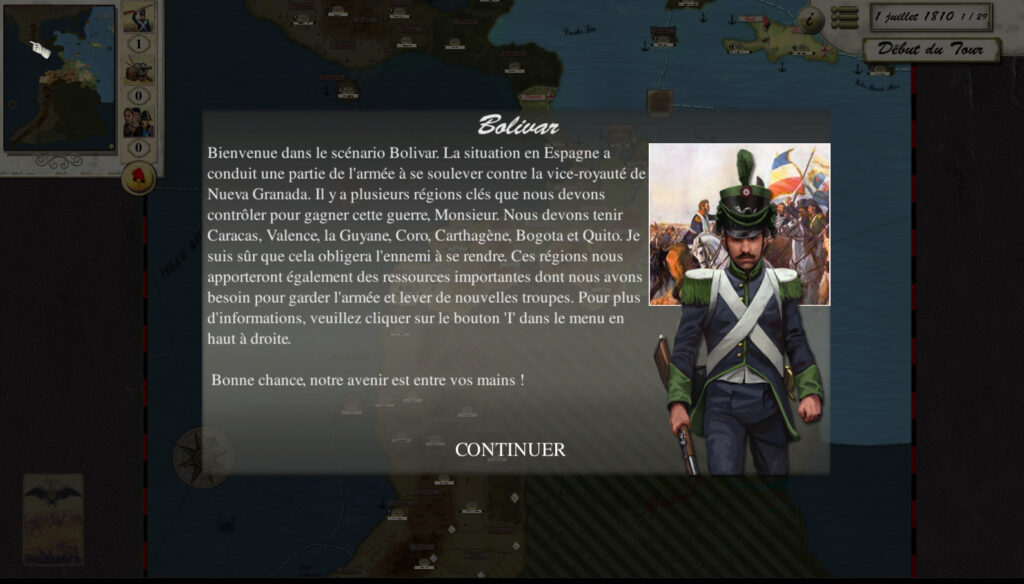
Perhaps because the game mechanics are fairly simple, and the AI has a limited number of options in terms to where to move and attack, the artificial opponent is competent and enjoyable to use. But, as is said probably too often these days, nothing takes the place of a conniving human opponent. But in this game, the need is not so great as in more complex wargames.
In fact, the AI did a better job maneuvering its fleets than this reviewer. Regarding the naval aspect, despite some serious playtime as the Royalists, I never encountered a situation where I had reinforcing land units available to offload at a port. Nor was I able to shuttle units around the map via transports.
Maybe I was missing something, but the naval experience was a bit lacking when playing the campaign game. Partly because the game moves along so quickly, it does have that “one more turn” feel that all players crave when investing money in a strategy title.
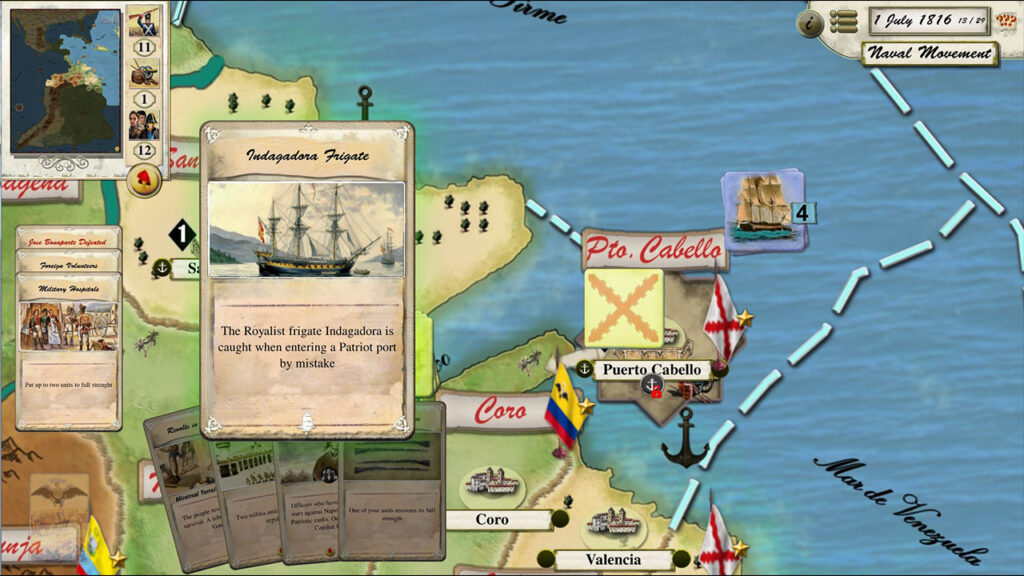
And now comes the tough part, and I will quote my Steam home page on this one: “Would you recommend this game to other players?”
If those players had only $25 to spend, I could not. This writer can recommend a number of superior wargames at, or close to, that price point, not to mention the discounts available during the current (2020) Steam Summer Sale.
But this wargame is a niche within a niche. So, for those gamers looking for a streamlined treatise on the Americas fight for freedom against Spain, this game is well worth the price.
Libertad o Muerte! is a truly unique wargame, and despite a couple of questionable design decisions, it remains “the only game in town” when it comes to simulating the Spanish Colonies’ wars of independence. Vaya con Dios!
Reviewed by Rosseau
Edited by Max Chee

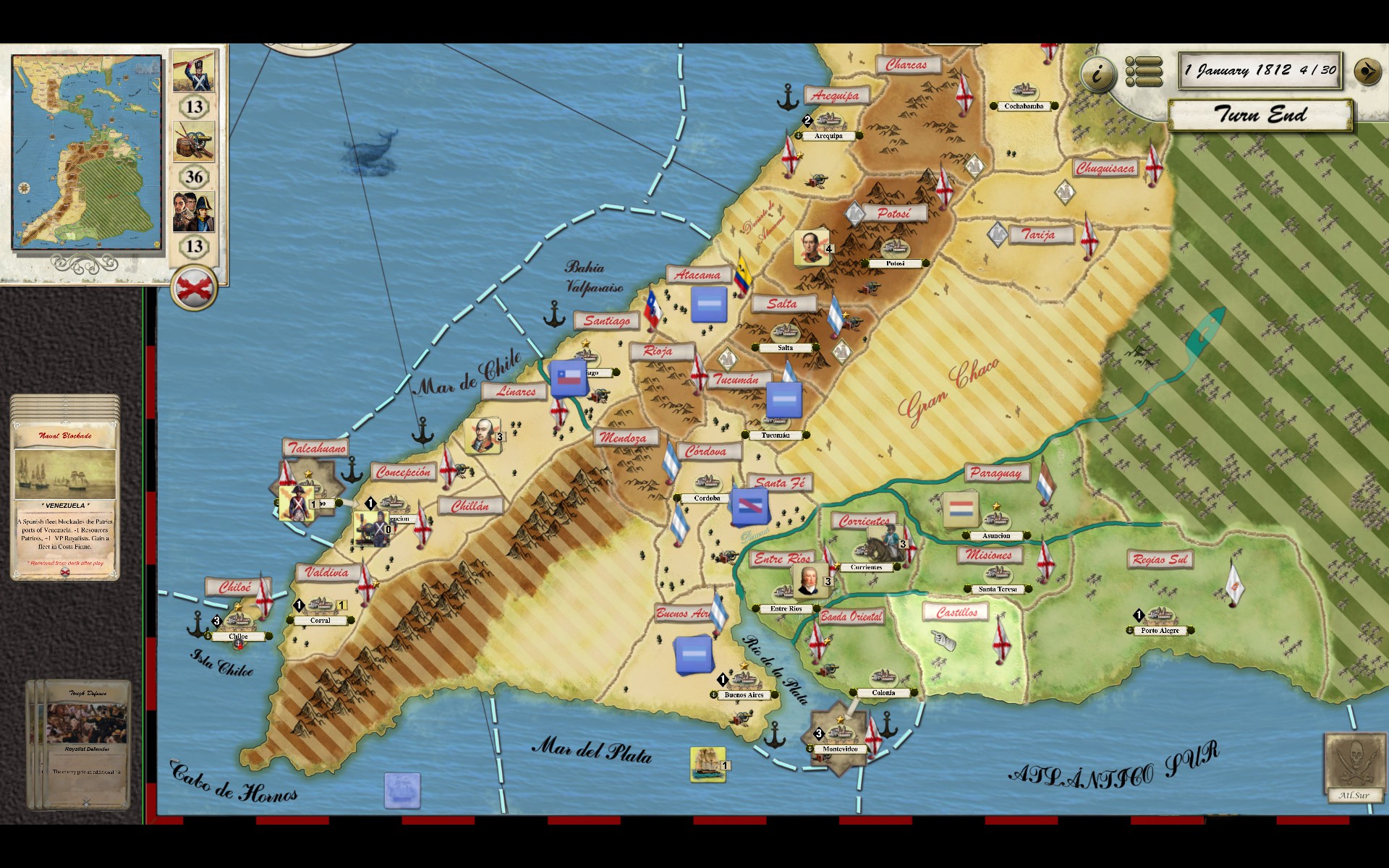
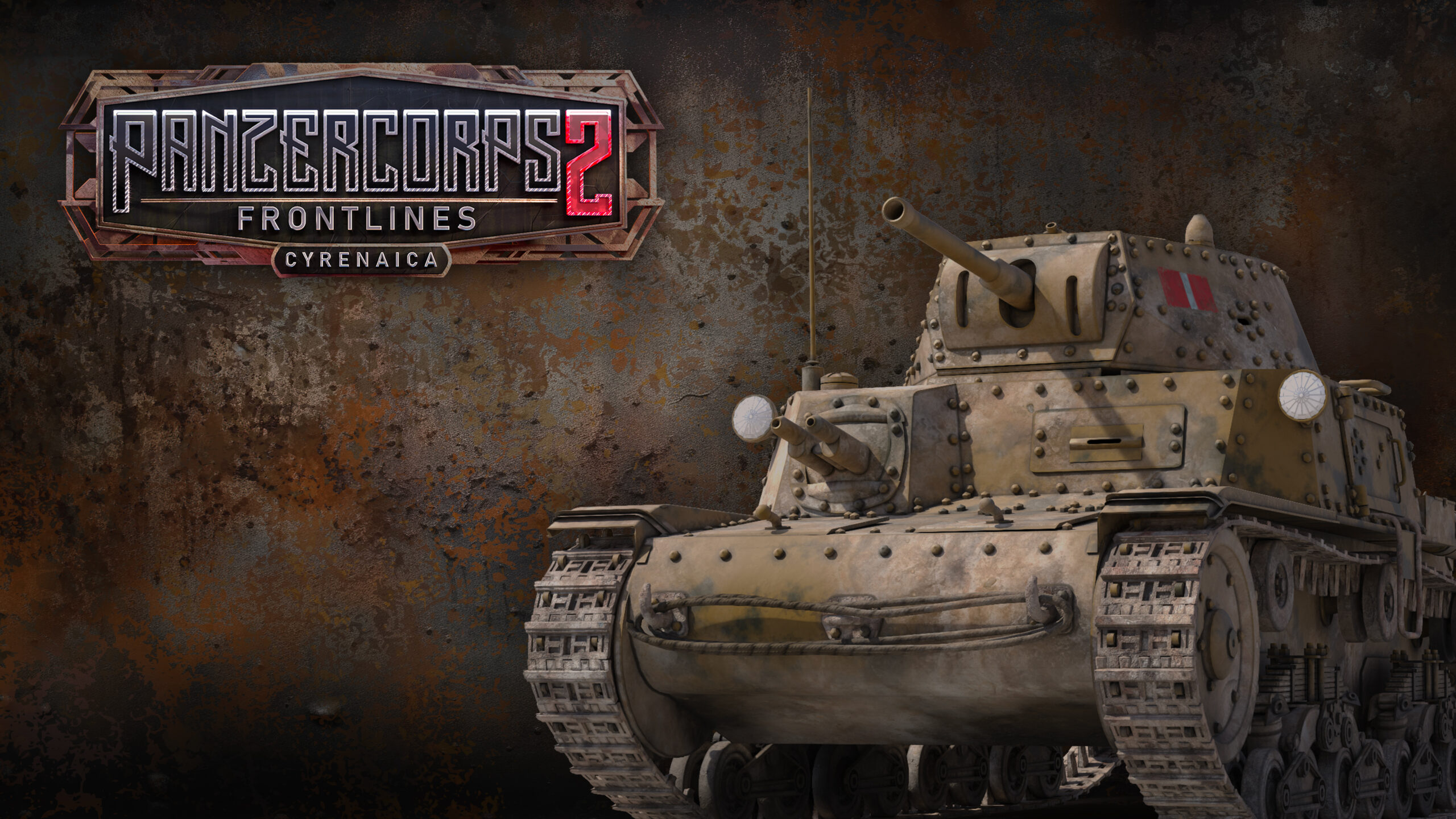




The scenarios of Libertad o Muerte! have been created with the free editor of War Across World. And they were meant to be played in war across the world. But War Across World (9 euro) was replaced by the engine of the Spanish civil war (B4S), a surrogate, dressed as the Latin-American revolution, libertad o muerte (22 euro). The result is that what costs 9 euros now costs 22 euros. why?, there is no free editor and you can’t play the WAW scenarios either. This has not been said, but the buyers should know.
I like cards and dice a lot and I like the original War Across World engine (WAW). But the question is what value added does the Headquarters engine, have that you paid 22 euros, for compared to 9 euros of WAW original?. The combat phase has worsened, The user lost all the WAW scenarios, the free editor and has paid double of money for nothing. Just dam be honest about your game when selling.
I don’t know if it can be important, but the game tells the wrong story about the war. It didn’t. The game has worsened historically and I don’t know the ultimate reason for these decisions. But the result has been that the most important thing about the campaigns in Latin America, which have been going on since 1820, are not really played. Turned point in 1820, the Spanish army revolts and does not embark to fight, and after 1820 the most emblematic battles take place in Latin America.
These three small scenarios pre-1820 have their origin in the “early campaign” scenario (redundant). These scenarios tehoretically were to incorporate a Phase of Supply (WAW) essential in Frederick style and guerrilla warfare, which is the heart of this pre-1820 campaigns. But it didn’t happen that way. Then, this is the reason why you do not understand the nature of the early war.
1)- Rio de La Plata
2)- Bolivar
3)- Mexico
Now you have early campaign(redundant) and South-America(redundant). But two big scenarios (post-1820) also do not exist, and should explain the regular warfare, on napoleonic style:
4)-Historical post-1820 total map campaign (Historical Latin American War of independence)
5)-Fictional post-1820 total map campaign (What if Spanish invasion).
British legions barely have a role in the game, but were essential in winning of Latin America. The British legion won the battle of Carabobo (year1821), and the destruction of the entire Spanish army in Venezuela. Even in the final battle of Ayacucho (year1824), it was the British legion that was sacrificed in a gorge to save the patriot army from defeat. But this happens at the end of the war, not early campaigns.
The Master and Commander, the role of Sir Thomas Cochrane is decisive, he led the Patriots Navy to annihilate the Spanish fleet. The game deals terrifyingly badly with naval warfare. It should be 1) a war of the patriotic navies (exercised by British and other foreign captains), on the South American coasts and seas, 2) but there is another naval war, of the insurgent privateers (mostly American captains) in the circumcaribbean and Spanish waters. For example was erased from the original map the historical privateers bases and ports of the circumcaribbean, its bays and historical islands. And it was replaced by those four markers that do not represent anything that has ever happened at privateers or fleets. The player might think that something happened there, a trade route perhaps, but no. Nothing ever happened in those four markers, historically talking about. Do it right doesn’t cost.
The best thing about the game is its collection of historical images, but a recognition of the original artists should be made in the manual. Look at the cover of that game. It’s a soldier paint by Cesar Puliafito, argentinean illustrator, that is superimposed on the painting of “El Abrazo de Maipú” 1908 Oil by Pedro Subercaseaux, Collection, Museo Histórico Nacional de Buenos Aires, Argentina. And so on with everything else. It doesn’t cost a single euro to put those names in the credit manual. Again, do it right doesn’t cost.
But I think the worst is that this game worsened the problem of combat phase. But, as it happened to Pinocchio, to have a soul, it is not enough to copy and paste and make a remix.
Finally, about a violation of copyright and intellectual property, see:
https://www.kickstarter.com/projects/787937257/libertadores/comments